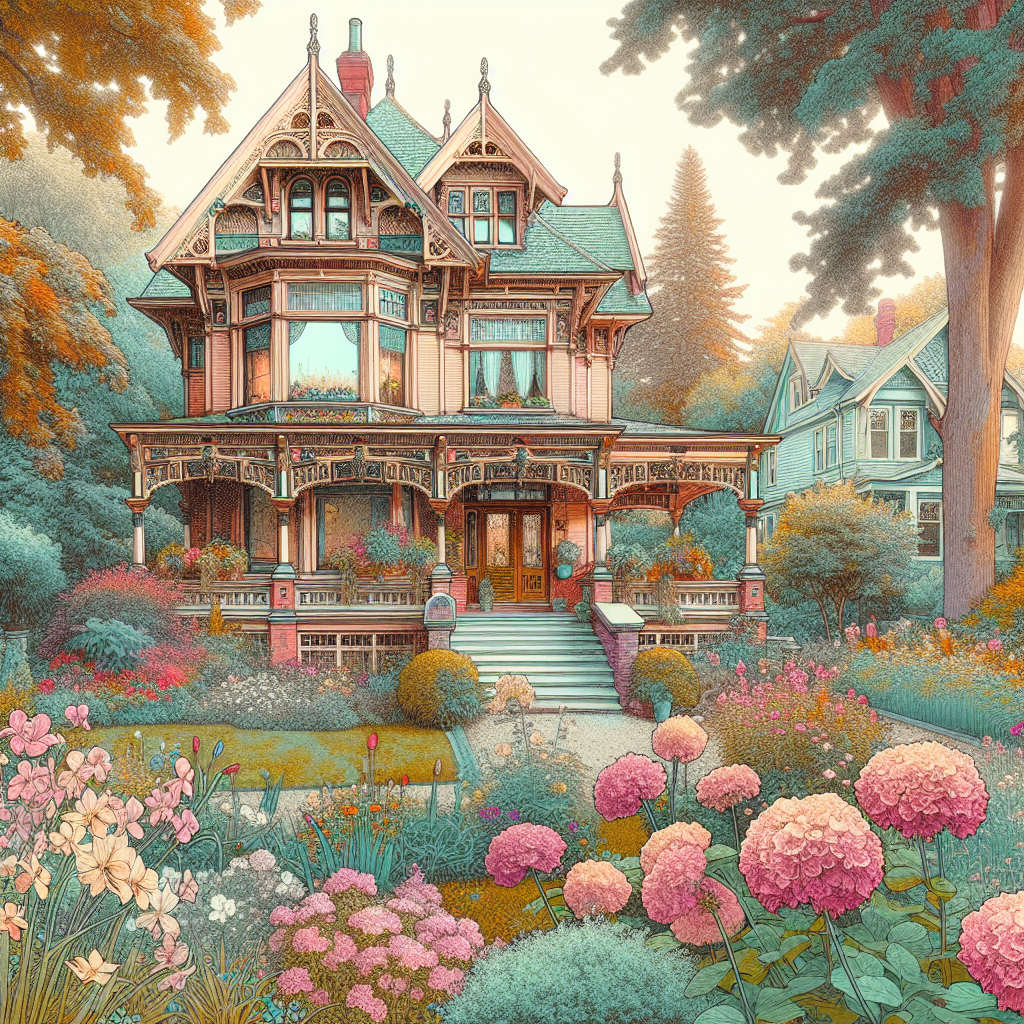Few architectural movements spark as much debate as the Victorian style. For some, it summons the eerie mansion from Psycho, with its labyrinthine corridors and perilous staircase concealing a chilling secret. For others, it paints a portrait of warmth and joy, reminiscent of the expansive, sunlit abode in Meet Me in St. Louis, boasting lofty ceilings and inviting verandas.
This dichotomy makes sense when you consider that “Victorian” — named after Queen Victoria, who reigned over Britain for the majority of the 19th century — denotes more a historical period and overall vibe than one fixed architectural blueprint. Multiple Victorian variations exist, each with its own signature flair. Here’s a comprehensive primer to guide you through the Victorian home universe.
The Victorian Epoch: Origins and Influence
Spanning from 1837 to 1901, Queen Victoria’s reign paralleled the Industrial Revolution’s rapid rise, a time when everything from sartorial choices to furniture design bore the stamp of newfound mechanization, urban growth, and an influx of wealth. For the freshly affluent middle and upper classes, residential architecture became a prime stage for conspicuous display.
With cities swelling and open land scarce, sprawling estates were out of the question. Instead, homeowners embraced lavish ornamentation to declare their status — gilding every cornice, installing balconies without obvious function, erecting turrets and towers, and decking out expansive porches. Interiors were similarly packed with coordinated furniture sets tailored to dining, living, sleeping, and study quarters.
Yet, by the early 20th century, Victorian extravagance began to wane, supplanted by the Arts & Crafts movement and modernist ideals, which championed simplicity and functionality over flourish and excess. As Tony Mariotti, CEO of RubyHome in Los Angeles, observes, “The decorative complexity gave way to a leaner, more restrained aesthetic.”
The post-World War II housing boom in the United States — fueled by the G.I. Bill and a surge in demand from returning servicemen — further stamped out ornate styles. “From 1945 forward, the market pivoted from bespoke craftsmanship to mass-produced, affordable homes,” Mariotti explains. Practicality trumped panache as builders raced to meet urgent needs.
Recognizing Victorian Characteristics
Victorian residences, whether nestled in urban cores or their fringes, rose vertically rather than sprawling outward. As Lucy Small of State and Season Home Design in Georgia puts it, “Keeping the home’s footprint compact was cost-effective, so these homes went up, not out.”
Adornments abound both inside and out, though specifics vary with regional influences and styles. Victorians embraced complexity in every detail, rarely shying from embellishment.
Inside the Victorian Home
“Signature elements include grand staircases, hefty mantels, imposing fireplaces, and compartmentalized rooms — no open-concept spaces here,” notes Small. Look for these hallmark features:
- Lofty ceilings trimmed with elaborate crown molding or ornamental friezes
- Dark-stained woodwork framing doors and windows
- Built-in cabinetry providing integrated storage
- Richly hued wallpapers, often in deep shades
- Labyrinthine floor plans carved into distinct chambers
- Ornate entry halls designed to impress
- Stained glass windows filtering colored light
- Modest bathroom counts, reflecting the infancy of indoor plumbing
Aside from aesthetic preferences, the prevalence of smoky coal and coke emissions from nearby factories influenced the dark color palettes — they masked grime filtering indoors, a practical nod amid Victorian industrial atmospheres.
Exterior Flourishes
Small highlights the Victorian penchant for “intricate trims along gutters, fanciful towers and turrets, and expansive wrap-around porches” as defining exterior traits.
Diverging sharply from the 18th-century doctrine of symmetry and balance, Victorian facades celebrate irregularity: bays jut out unexpectedly, turrets punctuate the skyline, roofs sport varied pitches, and windows of multiple shapes and sizes break the norm. Gables appear in surprising spots, while balconies and porches sometimes seem whimsically disconnected.
While interiors favored somber hues, Victorian exteriors often flaunted cheerful pastels, vivid shades, or textured brickwork and stonework, designed to pierce through the thick pea fogs blanketing many English cities.
Typologies Within Victorian Architecture
Given the era’s span, it’s no shock that multiple stylistic branches flourished simultaneously. Though overlapping features abound, six principal Victorian substyles dominate:
1. Queen Anne
This is the iconic Victorian: a flamboyant blend of elaborate ornamentation, asymmetrical facades complete with turrets, sprawling wraparound porches, steeply pitched multifaceted roofs, clusters of tiny windows, and profuse gingerbread trim. Multiple stories, including an attic and basement, add to its grandeur.
2. Italianate
One of the earlier Victorian variants, Italianate homes generally present a more rectilinear silhouette with near-flat roofs and a balanced facade. Large porches, often encompassing corners, add flourish but maintain a relatively symmetrical layout and consistent window and door sizing.
3. Gothic Revival
Drawing inspiration from medieval ecclesiastical architecture, Gothic Revival Victorians stand two or more stories tall and showcase pointed arches, steep roofs, towers, and complex, winding floor plans. Their spiky profiles evoke the grandeur of ancient cathedrals.
4. Richardsonian Romanesque (Romanesque Revival)
More frequently spotted in institutional constructions, these homes boast heavy masonry walls of reddish or brown stone, rounded arches crowning windows and doors, imposing towers, and soaring rooflines — a robust, fortress-like presence.
5. Eastlake (Stick Style)
Serving as a bridge between Gothic Revival and Queen Anne, Eastlake or Stick-style houses feature multiple stories, intricate wooden millwork, steep roof pitches, and prominent porches. Seen as a lighter alternative to its counterparts, it still indulges in spindlework and ornate trim.
6. Folk Victorian
Common among rural and emerging middle-class homes around the turn of the 20th century, Folk Victorians are noticeably more restrained. They typically feature symmetrical designs, practical rooflines, uniform windows, and modest embellishments, often centered around a spacious front porch.
Quick Victorian Facts: Victorian architecture spans over six decades (1837-1901) and includes dozens of substyles. Queen Anne remains the most prevalent in the US, often commanding premium prices. Historically, Victorian homes were built with materials such as brick, stone, and heavy timber. Modern restorations often require substantial investment — estimates put bespoke Victorian detailing at upward of $500 per square foot.
Considering a Victorian Home: Advantages and Challenges
Owning a Victorian residence means embracing a piece of history, often entailing a steeper price tag and the need for bespoke adaptations. The charming nooks, tight staircases, and maze-like hallways pose accessibility challenges — not ideal for seniors or those requiring mobility accommodations.
Additionally, the very walls that define these homes create modern frustration: “Victorian thick walls and certain materials can seriously impair Wi-Fi signals,” warns Mariotti, a technological nuisance in an otherwise classic setting.
What’s the Price Tag?
According to Mariotti, “While many Victorian homes on the market have undergone renovation, fixer-uppers still surface occasionally.” Though pricier upfront, renovated homes may save owners from costly long-term restorations. “Revamping a Victorian abode demands deep financial resources and patience.”
Costs vary widely by region, size, architectural details, and condition. Some estimates suggest that crafting an intricately detailed Victorian home can reach as steep as $500 per square foot.
Closing Thoughts on Victorian Living
Queen Victoria’s 64-year reign ushered in a remarkable architectural chapter, epitomized by urban middle-class homes boasting at least six main stylistic branches. For enthusiasts, commissioning a new Victorian-style build might prove more economical and satisfying than acquiring and rehabilitating a century-and-a-half-old mansion. Either way, living in a Victorian-style home places you among those who cherish distinctive charm and enduring character in housing.



